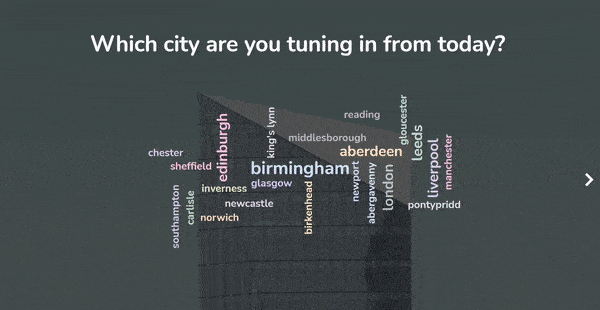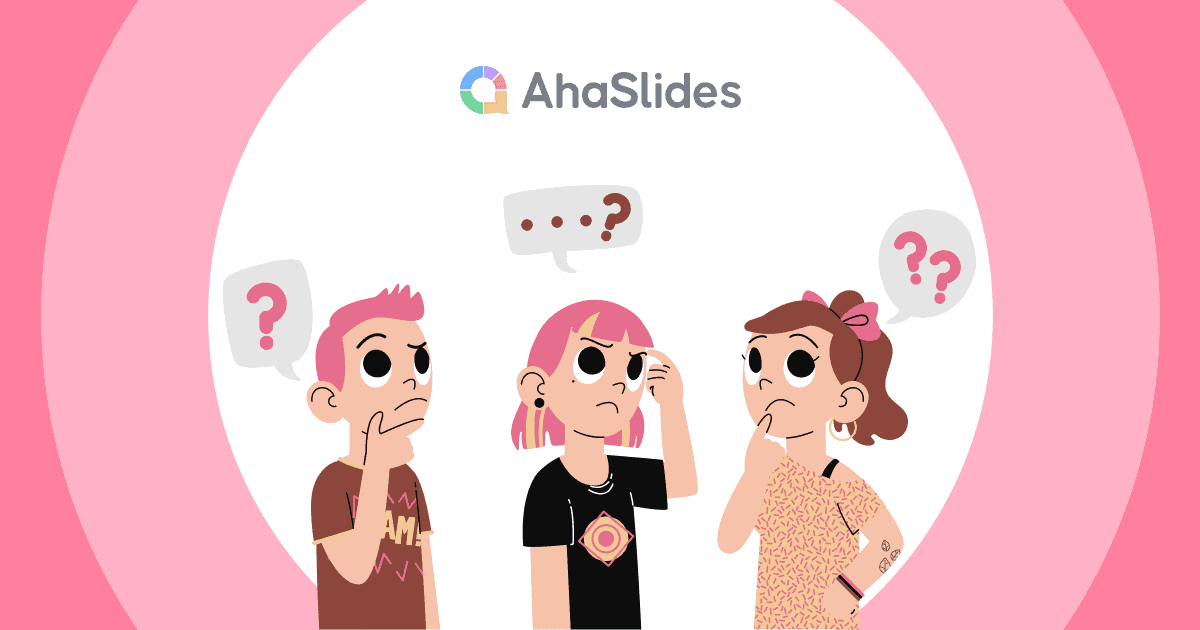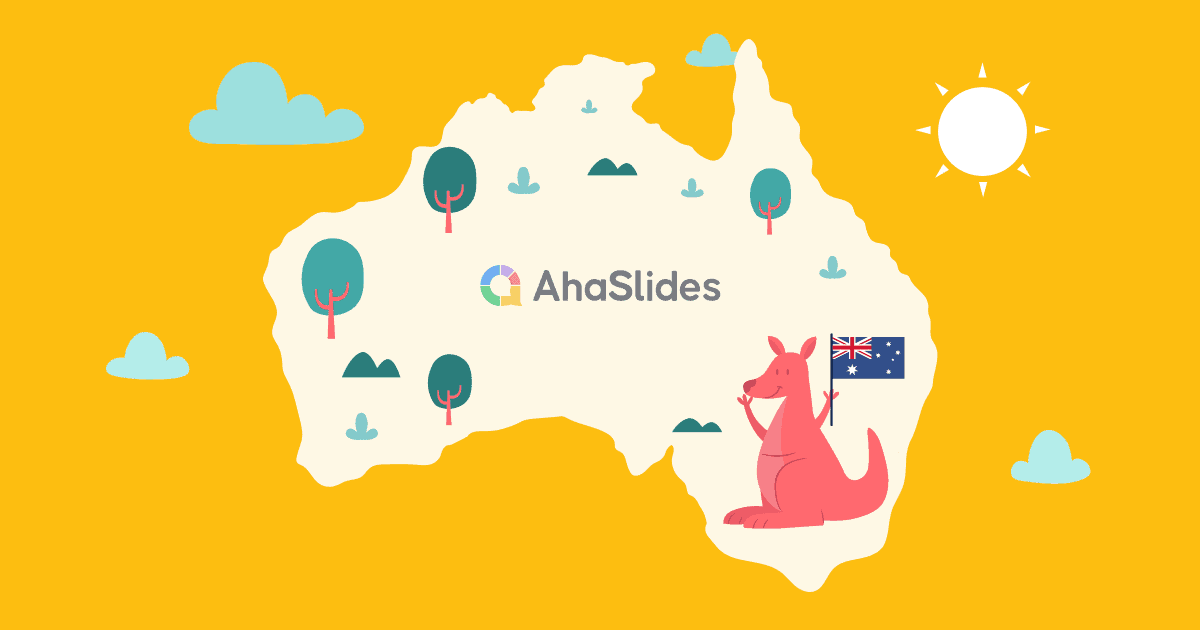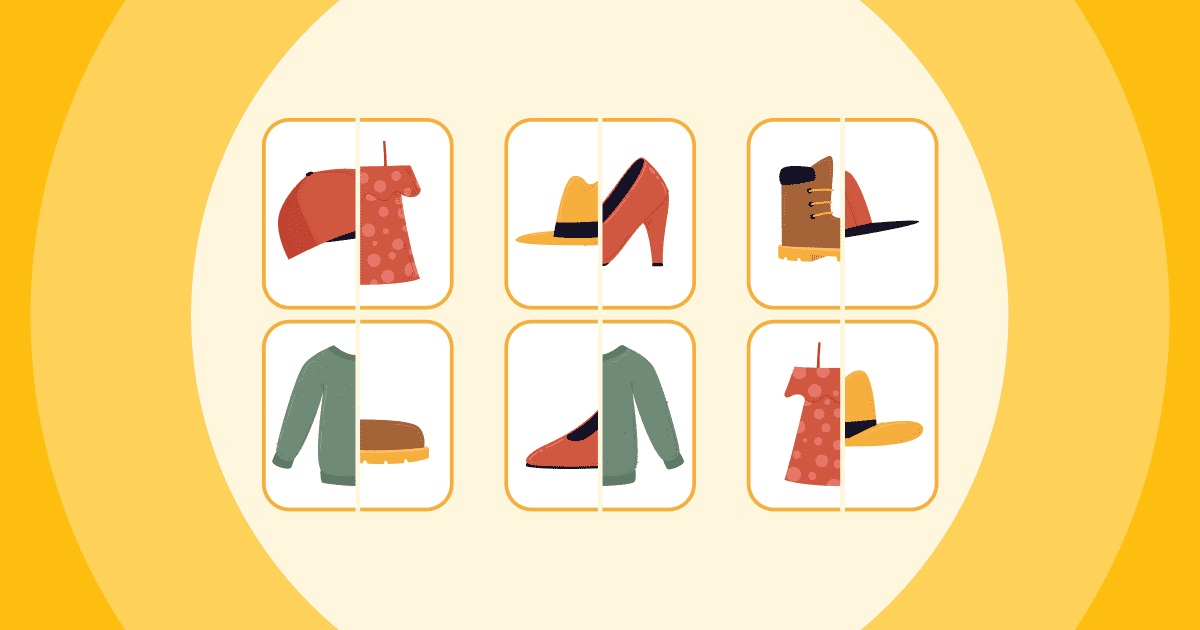調査を設計する際に直面する困難は何ですか? 以下をチェックしてみてはいかがでしょうか 締め切りの質問の例 今日の記事では、調査やアンケートを効率的に設計する方法をより深く理解できるようにします。

目次
クローズエンド質問とは何ですか?
アンケートで最も人気のあるタイプの質問の XNUMX つは、回答者が特定の回答または限られた選択肢から回答を選択できるクローズド質問です。 このタイプは、研究と評価の両方のコンテキストで一般的に使用されます。
関連する
自由回答式質問と自由回答式質問の違い
| オープンエンドな質問 | クローズドエンドの質問 | |
| あらかじめ決められた一連の回答選択肢に制約されることなく、回答者が自由に自分の言葉で回答できるようにします。 | 回答者が選択する必要がある、限られた回答オプションのセットを提供します。 | |
| 研究方法 | 定性的データ | 定量的データ |
| データ分析 | 応答はユニークで多様であることが多いため、分析にはより多くの労力と時間が必要です。 | 応答がより標準化され、簡単に定量化できるため、分析が容易になります。 |
| 研究の背景 | 研究者が詳細かつ微妙な情報を収集したり、新しいアイデアを探求したり、回答者の視点を理解したりしたい場合。 | 研究者がデータを迅速かつ効率的に収集したい場合は、大規模なサンプル全体で応答を比較するか、応答のばらつきを制限します。 |
| 回答者のバイアス | 回答は回答者の文章力や会話力、個人情報を共有する意思によって左右される可能性があるため、回答者バイアスが生じやすい可能性がある。 | 正確さと一貫性を確保するために回答の選択肢を慎重に作成できるため、回答者の偏見を最小限に抑えるように設計できます。 |
| 例 | 新しい会社方針についてどう思いますか? | 会社がXNUMX月に制定した新しい方針にどの程度同意しますか? |
クローズエンドの質問の種類 例
適切に設計された調査には、研究テーマのさまざまな側面に対処するために、さまざまな種類のクローズド質問を含めることができます。 さらに、質問は参加者から具体的かつ測定可能な回答を引き出すように設計され、研究方法に合わせて調整される必要があります。
さまざまな種類の質問を理解することは、アマチュアにとってもプロにとっても同様に重要です。 この知識は、研究者が研究に適切な質問を設計し、収集されたデータを正確に分析するのに役立ちます。
ここでは、クローズエンドの質問の一般的な 7 つのタイプとその例を示します。
#1 – 二分法的な質問 – 終了した質問の例s
二分法の質問には、「はい/いいえ」、「真/偽」、「公平/不公平」の 2 つの回答オプションがあり、品質、経験、または回答者の意見について質問するためのバイナリ データを収集するのに役立ちます。
例:
- イベントに参加しましたか? はい・いいえ
- 製品に満足していますか? はい・いいえ
- 私たちのウェブサイトにアクセスしたことがありますか? はい・いいえ
- フランスの首都はパリです。 A. 正しい B. 間違い
- CEO が従業員の数百倍の収入を得ることは公平だと思いますか? A. 公正 B. 不公平
#2 - 複数の選択肢 – クローズエンド質問の例
多肢選択は、アンケートのクローズエンド質問の例の XNUMX つとして最もよく使用されます。 通常、複数の可能な答えの選択肢が表示されます。
例:
- 当社の製品をどれくらいの頻度で使用しますか? (オプション: 毎日、毎週、毎月、まれに、まったくしない)
- 次の高級ファッション ブランドのうちどれが好きですか? (オプション: A. ディオール、B. フェンディ、C. シャネル、D. LVMH)
- 世界で一番長い川は次のうちどれですか? a. アマゾン川 b. ナイル川 c. ミシシッピ川 d. 揚子江
関連する 例を含む多肢選択問題の 10 種類のベスト タイプ
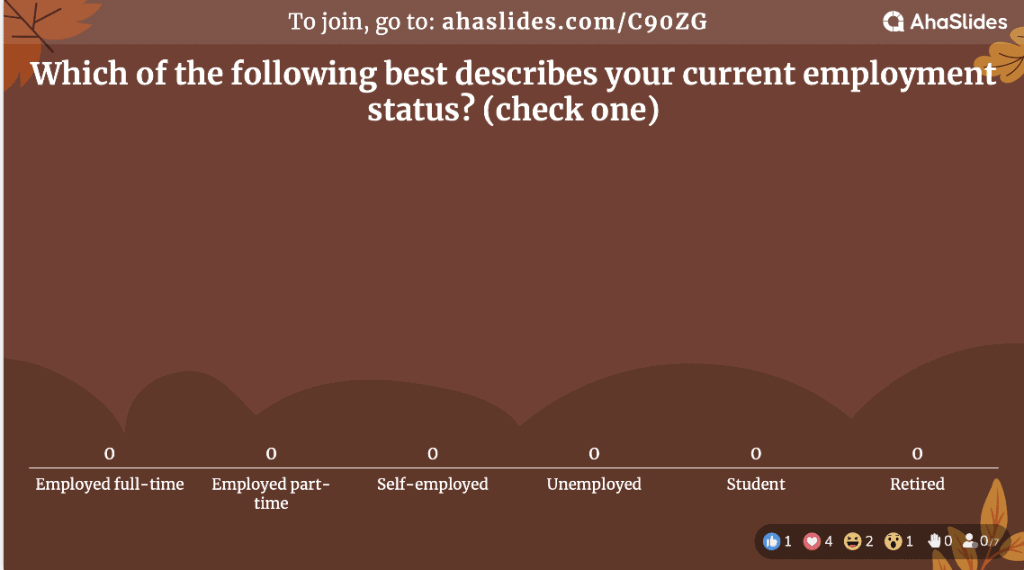
#3 – チェックボックス – クローズエンド型の質問の例
チェックボックスは多肢選択式に似た形式ですが、重要な違いがあります。多肢選択式の質問では、回答者は通常、選択肢のリストから1つの回答オプションを選択します。一方、チェックボックス式の質問では、回答者はリストから1つ以上の回答オプションを選択します。チェックボックスは、具体的な回答を示さずに、回答者の好みや興味についてより詳しく知るためによく使用されます。
例:
次のソーシャル メディア プラットフォームのうちどれを使用していますか? (当てはまるもの全てをご確認ください)
- Snapchat
過去 XNUMX か月間試した食品は次のうちどれですか? (該当するものをすべて選択)
- 寿司
- タコス
- ピザ
- 炒める
- サンドイッチ
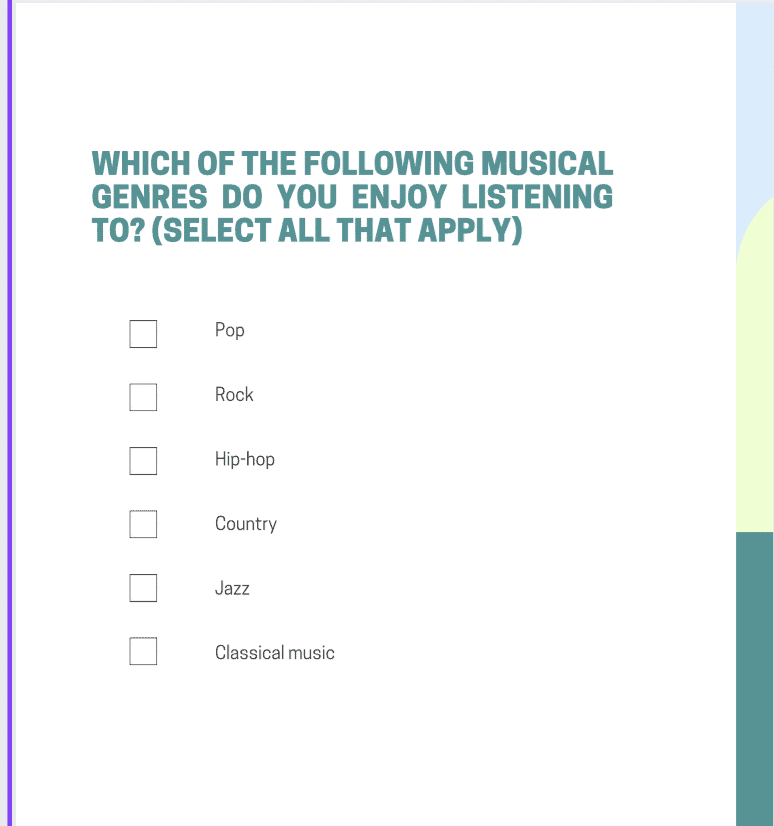
#4 – リッカート尺度 – クローズエンド型の質問の例
評価スケールの最も一般的な形式は、リッカート スケールの質問です。 研究者らはリッカート尺度の質問を使って調査を実施し、発言に対する同意または不同意のレベルを評価し、発言に対する肯定的または否定的な反応を測定しました。 リッカート尺度の質問の一般的な形式は、XNUMX 点または XNUMX 点の尺度です。
例:
- 受けた顧客サービスに満足しています。 (選択肢: 強く同意する、同意する、どちらでもない、同意しない、強く同意しない)
- 私たちの製品を友人に勧める可能性があります。 (選択肢: 強く同意する、同意する、どちらでもない、同意しない、強く同意しない)
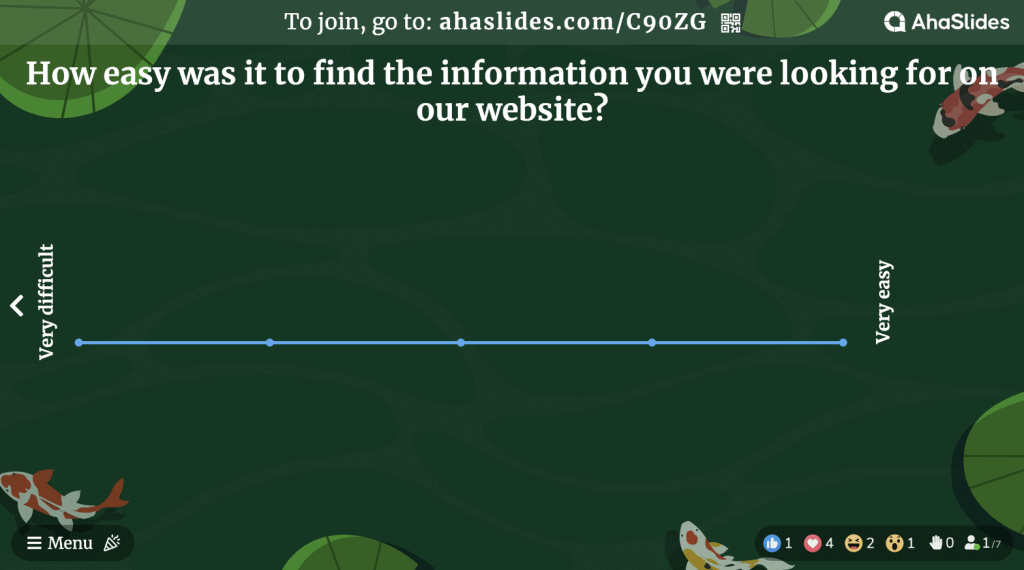
#5 – 数値評価尺度 – クローズエンド質問の例
評価スケールの別のタイプは数値評価スケールです。このスケールでは、回答者は数値スケールを使用して製品またはサービスを評価するように求められます。 スケールは、ポイント スケールまたはビジュアル アナログ スケールのいずれかです。
例::
- 当店での最近のショッピング体験に、1~5のスケールでどの程度満足していますか?1 – 非常に不満 2 – やや不満 3 – どちらでもない 4 – やや満足 5 – 非常に満足
- 当社の顧客サービスを 1 から 10 のスケールで評価してください。1 は悪い、10 は優れています。
#6 – 意味的差異質問 – クローズエンド質問の例
研究者が回答者に、対立する形容詞の尺度で何かを評価するように依頼しようとする場合、それは意味上の差異に関する質問です。 これらの質問は、ブランドの個性、製品の属性、または顧客の認識に関するデータを収集するのに役立ちます。 意味上の差異のある質問の例は次のとおりです。
- 当社の製品は: (オプション: 高価 – 手頃な価格、複雑 – シンプル、高品質 – 低品質)
- 当社のカスタマーサービスは以下のとおりです。(選択肢: フレンドリー – フレンドリーではない、役に立つ – 役に立たない、応答性が高い – 応答性が低い)
- 当社のウェブサイトは、(選択肢:最新 – 時代遅れ、使いやすい – 使いにくい、有益 – 有益でない)
#7 - ランキングの質問 – クローズエンド質問の例
ランキング質問は調査でもよく使用され、回答者は回答選択肢のリストを優先順位または重要性の順にランク付けする必要があります。
このタイプの質問は、市場調査、社会調査、顧客満足度調査でよく使用されます。 ランキングの質問は、製品の機能、顧客サービス、価格など、さまざまな要素や属性の相対的な重要性に関する情報を取得するのに役立ちます。
例:
- 当社製品の次の機能を、価格、品質、耐久性、使いやすさの重要性の順にランク付けしてください。
- レストランを選ぶ際に、料理の質、サービスの質、雰囲気、価格の要素を重要な順にランク付けしてください。
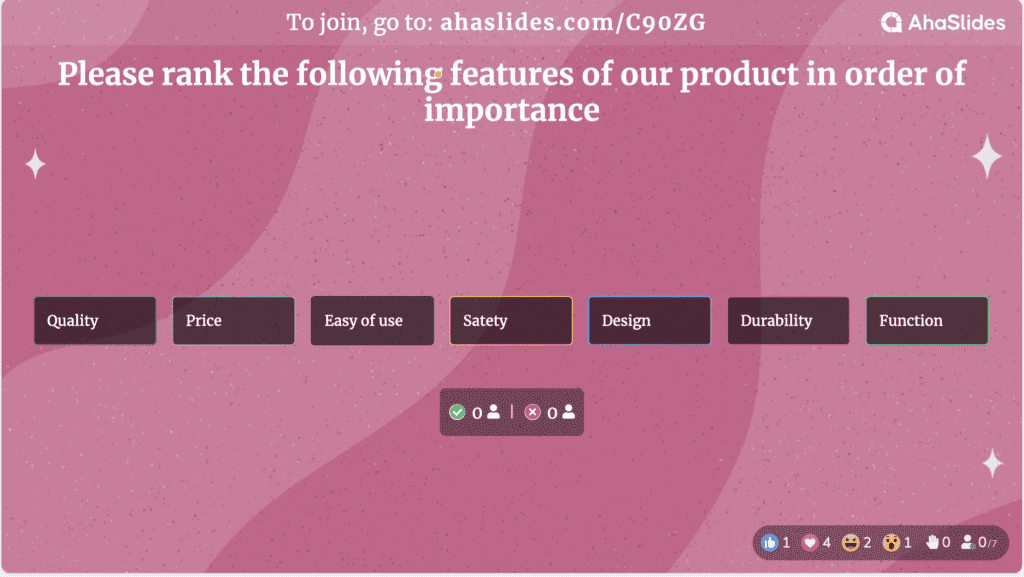
クローズエンドの質問の例をさらに見る
クローズドエンド式アンケートのサンプルが必要な場合は、さまざまなカテゴリの以下のクローズドエンド式質問の例を参照してください。 前述の例に加えて、マーケティング、ソーシャル、職場などのコンテキストでのクローズドエンド式アンケートの質問の例をさらに提供します。
関連する 学生向けアンケートのサンプル | ヒント付きの 45 以上の質問
マーケティングリサーチにおけるクローズエンド型の質問の例
顧客満足
- 最近の購入品にどの程度満足していますか? 1 – 非常に不満 2 – やや不満 3 – どちらでもない 4 – やや満足 5 – 非常に満足
- 今後、当社から再度ご購入いただく可能性はどのくらいですか? 1 – 全くない 2 – あまりない 3 – どちらでもない 4 – ややありそう 5 – 非常にありそう
ウェブサイトのユーザビリティ
- 当社のウェブサイトで探していた情報を見つけるのはどれくらい簡単でしたか? 1 – 非常に難しかった 2 – やや難しかった 3 – どちらともいえない 4 – やや簡単だった 5 – 非常に簡単だった
- 当社のウェブサイトの全体的なデザインとレイアウトにどの程度満足していますか? 1 – 非常に不満 2 – やや不満 3 – どちらでもない 4 – やや満足 5 – 非常に満足
購入行動:
- 当社の製品をどのくらいの頻度で購入されますか? 1 – 全く購入しません 2 – ほとんど購入しません 3 – 時々購入します 4 – 頻繁に購入します 5 – いつも購入します
- 当社の製品を友人に勧める可能性はどのくらいありますか? 1 – 非常に低い 2 – 低い 3 – どちらでもない 4 – 高い 5 – 非常に高い
ブランド認識:
- 当社のブランドについて、どの程度ご存知ですか? 1 – 全く知らない 2 – 少し知っている 3 – まあまあ知っている 4 – とても知っている 5 – 非常に知っている
- 1から5の尺度で、当社のブランドをどの程度信頼できるとお考えですか? 1 – 全く信頼できない 2 – やや信頼できる 3 – まあまあ信頼できる 4 – 非常に信頼できる 5 – 極めて信頼できる
広告効果:
- 当社の広告は、当社の製品を購入する決定に影響を与えましたか? 1 – はい 2 – いいえ
- 1から5のスケールで、当社の広告はどの程度魅力的だと感じましたか? 1 – 全く魅力的ではない 2 – 少し魅力的 3 – まあまあ魅力的 4 – とても魅力的 5 – 非常に魅力的
レジャーとエンターテイメントにおけるクローズエンドの質問の例
旅行業界
- どのタイプの休暇がお好みですか? 1 – ビーチ 2 – シティ 3 – アドベンチャー 4 – リラクゼーション
- どのくらいの頻度でレジャー旅行をしますか? 1 – 年に2回以下 2 – 年に3~3回 4 – 年に5~4回 5 – 年にXNUMX回以上
食物
- あなたの好きな料理は何ですか? 1 – イタリア料理 2 – メキシコ料理 3 – 中華料理 4 – インド料理 5 – その他
- どのくらいの頻度でレストランで外食しますか? 1 – 週2回以下 2 – 週3~3回 4 – 週5~4回 5 – 週XNUMX回以上
エンターテインメント
- あなたの好きな映画のジャンルは何ですか? 1 – アクション 2 – コメディ 3 – ドラマ 4 – ロマンス 5 – SF
- テレビやストリーミングサービスをどのくらいの頻度で視聴しますか? 1 – 2日1時間未満 2 – 3日3~4時間 4 – 4日XNUMX~XNUMX時間 XNUMX – XNUMX日XNUMX時間以上
会場管理
- イベントには何人のゲストが参加する予定ですか? 1 – 50人未満 2 – 50~100人 3 – 100~200人 4 – 200人以上
- イベント用に視聴覚機器をレンタルしますか? 1 – はい 2 – いいえ
イベントのフィードバック:
- 今後、同様のイベントに参加する可能性はどのくらいありますか? 1 – 全くない 2 – あまりない 3 – どちらでもない 4 – ややありそう 5 – 非常にありそう
- イベントの運営にどの程度満足しましたか?1~5段階でお答えください。1 – 非常に不満 2 – やや不満 3 – どちらでもない 4 – やや満足 5 – 非常に満足
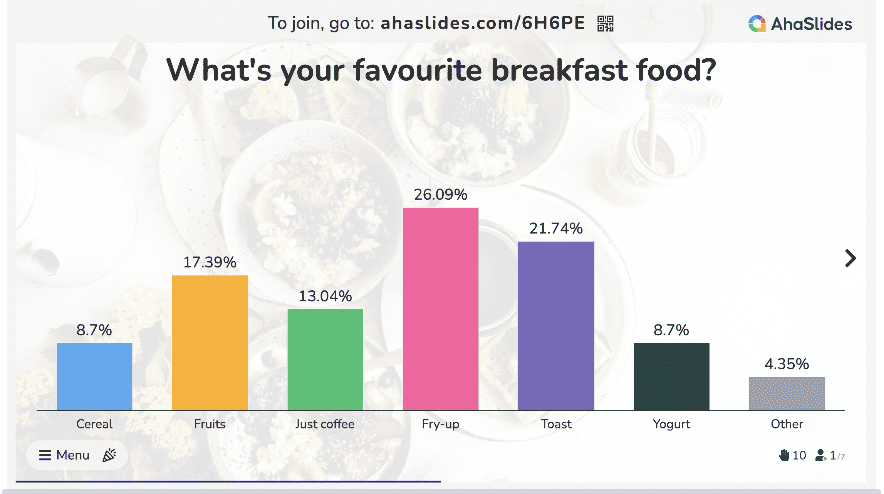
仕事関連のコンテキストにおけるクローズエンドの質問の例
従業員の関与
- 1から5のスケールで、あなたの上司はあなたとどれくらいうまくコミュニケーションを取っていますか?1 – 全くうまくいっていない 2 – あまりうまくいっていない 3 – どちらでもない 4 – ややうまくいっている 5 – 非常にうまくいっている
- 雇用主が提供する研修や開発の機会にどの程度満足していますか? 1 – 非常に不満 2 – やや不満 3 – どちらでもない 4 – やや満足 5 – 非常に満足
就職の面接
- 現在の学歴は? 1 – 高校卒業または同等 2 – 準学士号 3 – 学士号 4 – 修士号以上
- 以前、同様の職務に就いたことがありますか? 1 – はい 2 – いいえ
- すぐに始められますか? 1 – はい 2 – いいえ
従業員のフィードバック
- 仕事のパフォーマンスについて十分なフィードバックを受けていると感じていますか? 1 – はい 2 – いいえ
- 会社内でキャリアアップの機会があると感じますか? 1 – はい 2 – いいえ
人事考課:
- 今四半期に設定された目標を達成できましたか? 1 – はい 2 – いいえ
- 前回の評価以降、パフォーマンスを向上させるために何か対策を講じましたか? 1 – はい 2 – いいえ
社会調査におけるクローズエンド型質問の例
- どのくらいの頻度で社会奉仕活動にボランティアとして参加しますか? A. 決してしない B. めったにない C. 時々 D. 頻繁に E. 常に
- 「政府は公教育への資金提供を増やすべきだ」という次の意見に、あなたはどの程度賛成ですか、反対ですか。A. 強く賛成 B. 賛成 C. どちらでもない D. 反対 E. 強く反対
- 過去 XNUMX 年間に人種または民族に基づく差別を経験しましたか? A. はい B. いいえ
- あなたは通常週に何時間ソーシャルメディアに費やしますか? A. 0 ~ 1 時間 B. 1 ~ 5 時間 C. 5 ~ 10 時間 D. 10 時間以上
- 企業が従業員に低賃金を支払い、最小限の福利厚生を提供するのは公平でしょうか? A. 公正 B. 不公平
- 刑事司法制度は人種や社会経済的地位に関係なく、すべての個人を平等に扱っていると思いますか? A. 公正 B. 不公平
主要なポイント(要点)
調査やアンケートを設計するときは、質問の種類を選択するだけでなく、回答者が簡単に理解して従うことができ、後の分析でより良い結果が得られるように、質問は明確かつ簡潔な言葉で書かれ、論理的な構造に配置される必要があることを忘れないでください。
終了調査を効率的に実施するには、次のようなソフトウェアが必要です。 あはスライド 膨大な量の無料の組み込み機能を提供します 調査テンプレート リアルタイムの更新により、アンケートを迅速に収集して分析できます。

ライブQ&A プレゼンターまたはホストと聴衆の間でリアルタイムのやり取りを可能にする形式です。基本的には、プレゼンテーション、ウェビナー、会議、オンラインイベントなどで行われるバーチャルな質疑応答セッションです。この種のイベントでは、聴衆の意見表明を制限するクローズドエンド型の質問は避けた方が良いでしょう。アイスブレイクとして考えられるのは、次のような質問です。 ひっかけ質問 視聴者に向けて、またはリストをチェックしてください 何でも質問してください!
チェックアウト: トップ オープンエンドな質問 2024中!
よくある質問
クローズドクエスチョンの 3 つの例は何ですか?
クローズドエンド型の質問の例は次のとおりです。
– 次のうちフランスの首都はどれですか?(パリ、ロンドン、ローマ、ベルリン)
– 今日の株式市場は上昇して終了しましたか?
– 彼のこと好きですか?
終わりの言葉の例は何ですか?
クローズドエンド型の質問を構成する一般的な単語には、「Who/Whom」「What」「When」「Where」「Which/That」「Is/Are」「How many/How much」などがあります。これらのクローズドエンド型のリードワードを使うことで、曖昧さがなく、異なる解釈ができず、簡潔な回答が得られる質問を構築できます。
Ref: 確かに

